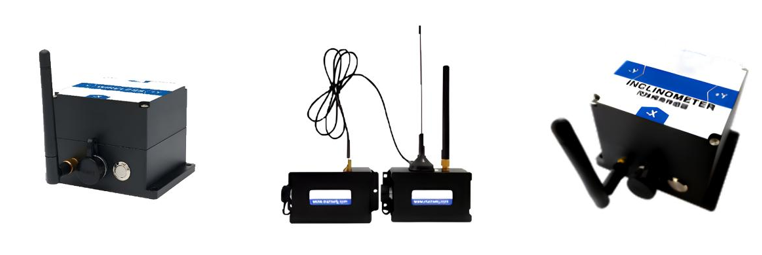Application of Tilt Angle Sensor in Monitoring Bridge Engineering Structures
Tilt angle sensors play a crucial role in bridge monitoring, mainly used to measure changes in the tilt angle of bridge structures or their key components relative to the direction of gravity. These minor changes are often important indicators of the health status, load response, foundation settlement, or potential diseases of bridge structures.
Monitor whether there is slow and uneven settlement of the bridge pier foundation, which may cause the bridge pier to tilt. By using tilt sensors to continuously record angle changes for a long time, trend data can be provided. Real time monitoring of changes in verticality or preset angles during the construction of bridge piers/towers to ensure construction accuracy.
→ Bearing Displacement and Rotation Monitoring
Monitor the rotation angle of bridge bearing under actual load. Abnormal changes in rotation angle may indicate aging, failure, or abnormal constraints of the bearing. By measuring the relative inclination angle between the top and bottom plates of the bearing, combined with the design parameters of the bearing, the sliding displacement of the bearing can be indirectly calculated.
→ Main Girder Alignment and Deformation Monitoring
Although direct deflection measurement typically employs displacement transducers or levels, installing inclinometers at specific locations (e.g., mid-span, pier tops) enables monitoring of rotation changes in girder cross-sections. By integrating these angular measurements with geometric parameters of the girder (such as length), the relative deflection trend at these positions relative to reference points can be calculated. This approach is particularly valuable for long-term structural health monitoring (SHM) and large-span bridges.
→ Cable Tower/Arch Rib Deformation Monitoring:
This process monitors angular changes in cable-stayed bridge towers or arch bridge ribs under load using inclinometers, assessing their global structural stability and deformation status.
MEMS tilt sensors are small in size, light in weight, easy to install on structural surfaces or embedded in specific parts, and have minimal impact on the structure itself; MEMS tilt sensors have low cost and lower unit price compared to traditional high-precision tilt meters or fiber optic sensors, making it economically feasible to deploy sensor networks on a large scale and in a dense manner, thereby obtaining more comprehensive structural state information; MEMS tilt sensors have low power consumption and are particularly suitable for wireless sensor networks powered by batteries or energy harvesting, enabling long-term, unmanned monitoring. MEMS tilt sensors are easy to integrate and digitize, typically outputting digital signals directly (such as I2C, SPI, RS485), making it convenient to integrate with data collectors and wireless transmission modules to build automated monitoring systems; MEMS tilt sensors are easy to install and the installation process is relatively simple, usually only requiring a fixed base or magnetic attraction. MEMS tilt sensors have strong dynamic response capabilities, and some high-performance MEMS sensors have sufficient bandwidth to monitor the dynamic response of structures (such as tilt changes caused by vibration)
Key Considerations in Applications
Bridge monitoring usually requires high accuracy (better than 0.01 ° or even 0.001 ° level) and stability. Although MEMS technology continues to advance, its long-term drift and temperature sensitivity remain challenges, especially when pursuing high-precision applications. It is necessary to carefully select sensor models that meet accuracy requirements and consider temperature compensation and regular calibration strategies.
The deformation of bridge structures usually does not change much in angle (often within the range of a few tenths of a degree to a few degrees), but sensors need to have high resolution and high linearity in a small range. At the same time, it is also necessary to consider the larger angles that extreme events (such as strong earthquakes) may produce.
Sensors need to be able to withstand drastic temperature changes, humidity, vibration, and possible electromagnetic interference in the bridge environment. Need to choose industrial grade or reinforced packaging products.
Tilt angle measurement refers to the angle between the sensor body and the direction of gravity. Therefore, the flatness, stability, and rigid connection with the measured structure of the sensor installation surface are crucial. Any slight deformation or looseness on the installation surface will directly affect the measurement results.
Use Case
Micro-Magic Inc has produced a series of MEMS tilt sensors to meet the needs of various application scenarios. Including 70 series, T700 series, T7000 series. All series of products are based on industrial design standards, covering both single axis tilt sensors and dual axis tilt sensors. Signal output includes digital and analog (current, voltage) outputs. The measurement accuracy covers the range of medium to high precision. All products support or can be customized with RS232/RS485/RS422/TTL/CAN/MODBUS communication protocols.

Micro-Magic Inc has also produced a series of single board tilt sensors, which are convenient for customers to integrate into their own systems.

For the special scenario of bridges and dams, Micro-Magic Inc has also launched a series of wireless tilt sensors,. Powered by lithium batteries and based on IoT technology Bluetooth and Zigbee (optional) wireless transmission technology, it avoids application limitations caused by wiring.

MEMS tilt sensors, with their unique advantages, provide an economical, efficient, and easy to deploy local angle monitoring method for bridge structural health monitoring. It plays a critical role in monitoring areas such as pier inclination, bearing rotation, and deformation trends of main girders, especially suitable for large-scale deployment and long-term automated monitoring. With the advancement of technology and the improvement of data processing capabilities, its application in bridge monitoring will become more in-depth and intelligent.

Xml política de Privacidade blog Mapa do site
Direitos autorais
@ Micro-Magic Inc. Todos os direitos reservados.
 SUPORTADO POR REDE
SUPORTADO POR REDE
